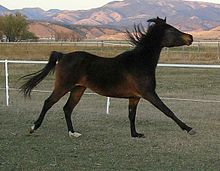 Global Information
Global InformationCerebellar abiotrophy information
| Cerebellar abiotrophy | |
|---|---|
| Other names | cerebellar ataxia, CA, CCA |
 | |
| A two-year-old Arabian horse with cerebellar abiotrophy, showing stiff awkward gait, and upper range of unnatural head bob. Though this horse had a relatively mild case, it could never be ridden. | |
| Pronunciation |
|
| Specialty | Veterinary medicine, genetic diseases |
| Symptoms | ataxia, hyperreactivity, inability to judge distance |
| Complications | death due to injuries sustained |
| Usual onset | at or shortly after birth |
| Duration | lifelong |
| Causes | genetic mutation causing loss of purkinje cells in the cerebellum |
| Risk factors | falls, colliding with objects |
| Diagnostic method | DNA test, post-mortem examination of brain tissue |
| Differential diagnosis | Wobbler syndrome, EHV-1, Equine Protozoal Myeloencephalitis, concussion |
| Prevention | Avoid breeding carrier animals |
| Treatment | None |
| Medication | None |
| Prognosis | Varies by severity, severely disabled animals may be euthanized for humane reasons. |
| Frequency | Varies by species and breed |
Cerebellar abiotrophy (CA), also called cerebellar cortical abiotrophy (CCA), is a genetic neurological disease in animals, best known to affect certain breeds of horses, dogs and cats. It can also develop in humans. It develops when the neurons known as Purkinje cells, located in the cerebellum of the brain, begin to die off. These cells affect balance and coordination. They have a critical role to play in the brain. The Purkinje layer allows communication between the granular and molecular cortical layers in the cerebellum. Put simply, without Purkinje cells, an animal loses its sense of space and distance, making balance and coordination difficult. People with damage to the cerebellum can experience symptoms like unsteady gait, poor muscle control, and trouble speaking or swallowing.[1]
Abiotrophy means the loss of a vital nutritive factor. The cause of cerebellar abiotrophy is not known, but it is thought to be due to an intrinsic metabolic defect.[2]
In most cases, the Purkinje neurons begin to die off shortly after the animal is born and the condition is noticeable when the animal is less than six months old, though sometimes the onset of symptoms is gradual and the animal is much older before the owner or caretaker notices a problem.
Cerebellar abiotrophy cannot be prevented, other than by selective breeding to avoid the gene, and it cannot be cured. Genetic testing can detect carriers. In addition to dogs and horses, there also have been cases of cerebellar abiotrophy in Siamese and Domestic shorthair cats; in Angus, Polled Hereford, Charolais and Holstein Friesian cattle; Merino and Wiltshire sheep; and Yorkshire pigs.
- ^ NINDS Cerebellar Degeneration Information Page Archived 2015-02-18 at the Wayback Machine, National Institute of Neurological Disorders and Stroke, accessed May 5, 2016
- ^ Sandy J, Slocombe R, Mitten R, Jedwab D (2002). "Cerebellar abiotrophy in a family of Border Collie dogs". Veterinary Pathology. 39 (6): 736–738. doi:10.1354/vp.39-6-736. PMID 12450206.